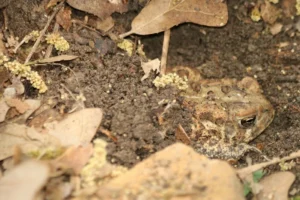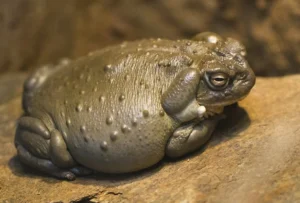There are also many misconceptions about toads. A few researchers previously reported that some frogs and toads never sleep. However, these ideas have been challenged, and the current scientific consensus is that virtually all animals (including all toads), show some form of sleep or at least sleep-like states.
In general, toads will sleep in cool areas on the ground that are sheltered from direct sunlight and also offer some form of protection against predators. This could be in leaf litter, compost heaps, inside rotting logs, in rock crevices, under rocks, or even in underground burrows.
Toads are also known to dig deep down into loose soil. Many toads have special, hardened knobs on their hind feet that help them dig into the soil.
Some toads can burrow anywhere from 6 inches to over 3 feet deep.
Most Toads Sleep In Sheltered Locations On Land
Toads spend most of their lives on land and have features suited for this terrestrial lifestyle.
Toads typically have short hind legs (for walking or hopping short distances) and non-webbed feet (they typically have digits or spaded feet).
This is in contrast to most true frogs which have long powerful hind legs (for hopping long distances & propelling themselves in water) and fully webbed feet.
To sleep toads will typically seek out cool areas on the ground that are sheltered from direct sunlight and also offer some form of protection against predators.
Toads will sleep:
- In leaf litter, compost heaps
- Inside hollow logs, cracks in logs, rotting wood
- In caves, rock crevices, and cracks in the foundations of old buildings
- Under rocks, logs, piles of rubble, paving slabs, and other objects
Many toads will also sleep in underground burrows – often in natural holes or abandoned small mammal burrows.
Some toad species may also dig their own burrows.
Toads are known to dig deep down into loose soil. Many toads have special, hardened knobs on their hind feet that help them dig into the soil. They use their back legs to ‘knead’ their bodies into the soil, burying themselves completely.

How deep they dig can vary from time to time. As mentioned earlier, some toads can burrow anywhere from 6 inches to over 3 feet deep.
What We Know About Sleep In Toads
Put simply, sleep is a period of reduced activity that is characterized by changes in brain wave activity, breathing, heart rate, body temperature, and other physiological functions.
Two main states are recognized in humans, and other mammals, as well as in birds: slow-wave sleep, also called non-REM sleep, or quiet sleep, and paradoxical sleep, also known as REM sleep or active sleep.
While both quiet sleep and active sleep have clearly been identified in mammals and birds, their presence in frogs and toads remains highly debated.
In 1982, Ida Gavrilovna Karmanova conducted a study to understand the evolution of sleep in vertebrates –and concluded that amphibians and fish show three forms of rest or sleep-like states (SLS), named ‘protosleep’ or ‘primary sleep’.
- Cataleptic (plastic muscle tone) or protosleep 1
- Catatonic (rigid muscle tone) or protosleep 2
- Cataplectic sleep (atonia)or protosleep 3
Cataleptic sleep appears mainly during the day when the eyes are open, whereas Catatonic and Cataplectic sleep are observed during nighttime rest periods.
The arousal threshold increases relative to the type of protosleep, and the heart rate decreases accordingly.
How Do Toads Sleep?
There are over 7,000 described frog and toad species, living in a wide range of habitats.
For this reason, the exact sleeping posture, and behavior may vary among different toad species, that said, there are a few common behaviors that have been observed in several species of frogs when in a sleeping state.
Many toad species in a sleep state will be:
- Immobile
- Have their eyes closed
- Their limbs tucked under their body
- And their heads pointing downwards

When toads sleep, they generally close their translucent third eyelid, known as the nictitating membrane. Since this membrane is translucent, toads’ eyes may appear open when they sleep – and they can still see and react to their surroundings.
When Do Toads Seep?
The majority of toad species are primarily either nocturnal or crepuscular and are most active in the dark and twilight hours. However, toads can sleep at any time of the day.
According to Ida Gavrilovna Karmanova (1982), frogs show Cataleptic sleep mainly during the day and show Catatonic and Cataplectic sleep during nighttime rest periods.
Scientific Research On The Sleep Behavior Of Frogs & Toads Is Limited
There are over 7,000 known frog and toad species on the planet, and less than 1% of these species have been studied in the context of sleep.
For this reason, what we currently know about the sleep behavior of frogs and toads is very limited and may change in the future, with more scientific research.
Some authors previously reported that some frogs, fish, and other animals such as crocodiles never sleep. However, these ideas have been challenged, and the current scientific consensus is that virtually all animals (including all frogs and toads), show some form of sleep or at least sleep-like states.
Sleep enables toads to conserve, or restore energy, and also performs many other important functions.
Conclusion
Like virtually all animals, toads show some form of sleep.
Humans and other mammals have 2 sleep states, namely; slow-wave sleep, also called non-REM sleep, or quiet sleep, and paradoxical sleep, also known as REM sleep, or active sleep.
The presence of these sleep states in anurans is not clear and is still highly debated, although some authors suggest quiet sleep (non-REM sleep) may exist in frogs and toads.
Featured image credit: Tom Jutte (CC BY-NC-ND 2.0)
Sources:
Hobson, J. A., Goin, C. J., & Goin, O. B. (1967). Sleep Behavior of Frogs. Quarterly Journal of the Florida Academy of Sciences, 30 (3), 184–186. http://www.jstor.org/stable/24314832
Karmanova, I. G., Evolution of Sleep: Stages of the Formation of the “Wakefulness-Sleep” Cycle in Vertebrates. 1982. Karger, Basel, Originally Published in Russian by Nauka Publishers, Leningrad.
J. Allan Hobson, Electrographic correlates of behavior in the frog with special reference to sleep, Electroencephalography and Clinical Neurophysiology, Volume 22, Issue 2,1967, Pages 113-121, ISSN 0013-4694, https://doi.org/10.1016/0013-4694(67)90150-2.
Libourel PA, Herrel A. Sleep in amphibians and reptiles: a review and a preliminary analysis of evolutionary patterns. Biol Rev Camb Philos Soc. 2016 Aug;91(3):833-66. doi: 10.1111/brv.12197. Epub 2015 May 29. PMID: 26031314.
(2008). Do all animals sleep?. Trends in neurosciences. 31. 208-13. 10.1016/j.tins.2008.02.001.


